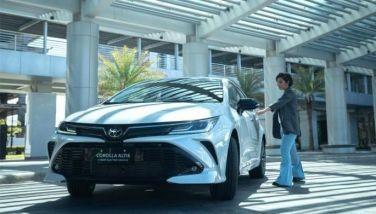Which bike racks are right for you?
MANILA, Philippines - So you’ve got yourself a new bike? Congratulations. Welcome to a whole new world of freedom and independence.
But if you’re like most newbies, however, chances are you probably spent a great deal of time harassing a friend who already bikes to guide you through each and every component, and lost track of the amount of texts that said, “Pare, is a Giant a good bike” or, “What is a group set? And why is it so mahal?”
That’s normal, though. So if you did, don’t feel bad. But what is not normal during a purchase of a new bike is asking how you plan to transport this shiny new freedom machine to the footsteps of the great outdoors. This is where I come in.
I’ve seen it happen a hundred times. Heck, it happened to me, so it’s pretty much first hand knowledge that I’m drawing from. You spend a small fortune on a bike, then realize that unless you plan on riding around your village, you’ll need to shell out another healthy chunk on a bike rack. But which one?
There are plenty of options available, but for the sake of space, I’ve narrowed it down to the most popular models.
Thule Roof Rack with Pro Ride 591
This could by far be the best choice in terms of reliability and quality. Thule has been the undisputed market leader in cargo solutions and transporting large sporting equipment for 70 years now; and if you love your bike, and happen to use a single vehicle to transport it, this is the ticket.
The idea is that the bike sits on a gutter-type rail with tire straps, but is held in place almost entirely by the center (lockable) arm bar that clamps onto the frame. The wheel straps are simply there to prevent the wheels from bouncing off the rails.
I’ve used two of these on my pick up for almost three years and I can swear by them. There have even been times where I forgot to attach the wheel straps, and although the bike did fall off the rails after hitting a bump, it never came loose from the arm bar.
They have been track tested and crash tested to extreme speeds, and have passed with flying colors. The only downsides are, well, they’re not cheap. Expect to pay around P30,000 for a cross bar and Thule Pro Ride 591. Add another P14,000 or so for an extra bike carrier if you have two bikes. Also, you really want this to be dedicated to one vehicle. If you switch vehicles, you will need to buy adapters to fit, plus it requires a bit of work to transfer them. And lastly, depending on the height of your vehicle (and your height, too) it can be a little tricky getting the bike up there. Oh, and there have been some issues being charged as a class 2 vehicle on the expressways because the sensors work solely on the height of the vehicle.
Thule tow bar mounted rear carriers
If you have an SUV, pick up or van, this could be the next best thing. It comes with the same peace of mind of all Thule products, but with the added convenience of not having to lift your bike up so high or deal with disputed class 2 charges on your epass.
I’ve transported two bikes using this system on long out of town trips, and was thankful for the convenience it offered. The only compromises you have here are that you really want to use extra straps to avoid the bikes rubbing together. Plus in some cases, rear vision is obstructed. Also, being at eye/street level, you really need to pull off all the accessories when parked because it becomes a target for thieves. But the deal-breaker for me is that, while the bikes are very secure, one rear end collision could end up costing a fortune as your bikes are right in the line of fire.
Trunk mounted portable bike carriers.
This is by far the most inexpensive way to transport your bike. There are brands like Hollywood that sell them for as low as P5,000. It’s not flash, but it does do the trick.
I haven’t had a lot of experience with these, but my brother has one and finds it messy. Also, it is not as universal as I hoped. If your SUV or van has a rear roof mounted spoiler, which majority of them do (Fortuner, Hi Ace, CRV etc) you cannot use them. Plus you still have the vulnerability of rear end collisions and/or theft.
In my experience, nobody has ever fiddled around with my bikes once they are mounted on a roof. It draws way too much attention. Plus it is inaccessible and, because it is lockable, it acts as a natural deterrent.
Having your bikes at eye level leaves you feeling quite insecure when you park up at a mall or restaurant after your ride, but if you really want to spend as little as possible, this seems like a frugal choice.

Sea Suckers
I just got my hands on these little suckers and it is almost impossible to not be impressed by them. The idea is so simple that it kind of just fell off the radar of the bigger companies, much in the same way that NASA reportedly spent a fortune on developing a space-age pen that used reversed polarized molecules that allowed the ink to still flow in a gravity-free environment so that astronauts could write in space, while the Russians brought a pencil.
Basically, they are just over grown, heavy duty, vacuum-type suction cups. If you’ve ever had a GPS device mounted on your windscreen, you’ve got the picture. There are several models to choose from – a single, double and triple fork-mounted bike carrier, starting at P14,000.
Each comes with a rear wheel suction cup that straps the rear wheel down to prevent it from bouncing around and swinging, although it’s the front mount that is doing all the work here.
I have tried these out for a month or so now, on about six different cars of various shapes and sizes, and have carried up to three bikes at a time. I’ve taken it up to speeds of 180km/h and cornered hard in them and have yet to experience any issues. They are rated to hold up to two hundred pounds and stow neatly away in your trunk when you’re not using them.
And because they are suction cups, the mounting positions are almost endless, meaning you could transport three bikes in a Ferrari, Porsche or Alto. I prefer to keep the front mounts on the glass, because I’m 100% sure that it is a smooth, flat surface, but it works just as well on the roof, the trunk, and even the hood.
These are the perfect racks for someone who switches cars a lot – like a motoring journalist, or a triathlete that arrives in a new place and needs to rent a car. The single bike carrier model fits in my back pack, which means I can now bike from home to a dealership, pop out the suckers, and drive off in my test vehicles with my bike securely fastened to them. Plus once I remove my bike to go riding at my favorite trail, I can lock up the sea suckers in the trunk and away from prying eyes.
As far as convenience goes, you won’t find anything better. So let’s take a quick look at the downsides.
Although I’ve experienced no issues, being a suction cup means that it is capable of losing air. They are equipped with an indicator, of course, that tells you if they are losing air, but as good as they are (and as much warning as they give you) because it is a new approach, they don’t offer the same peace of mind as a permanently mounted Thule Roof Rack. Given time, I’m sure I will build more trust in them, but for now, I do find myself stopping once or twice along the way just to check on them.
Secondly, you do need to remove your front tire. It’s a small price to pay considering that all bikes have a quick release, but its an added step. And lastly, while they have been speed tested to over 250 km/h in a NASCAR, they haven’t been crash tested like the Thule Roof racks have.
The bottom line here is that each rack suits a different need. Some bikers drive a few kilometers down to a trail and need the most simple and most cost-effective solution. Some drive 50-100 kilometers on the highway to get to a biking spot and are transporting a million pesos worth of bikes. While others own only a bike and no car, and rely solely on borrowing their motorized wheels from their folks or catching a lift with friends.
So, if you are after 100% peace of mind, and are prepared to leave the racks on semi-permanently, then the Thule Roof mounted racks are the most practical choice. If you want the same quality, but at a more convenient height, then you may want to look at the tow bar mounted hitches or the trunk-type carriers. But if you happen to switch cars a fair bit and need flexibility, or you have a sports car whose sleek lines are vandalized by bulky racks, then you’ll be a sucker for the Sea Suckers.
- Latest






























